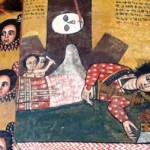 Modern cities, like Addis Ababa, are becoming overrun with advertisements, with companies using every opportunity for product placement.
Modern cities, like Addis Ababa, are becoming overrun with advertisements, with companies using every opportunity for product placement.
Even historic sites are not immune to the infestation, with many highly significant squares becoming canvases for the multinationals to paint their own garish pictures. Tibebeselassie Tigabu discovers how this is possible.
Ethiopian history books had recorded the execution of Brigadier General Mengistu Neway in 1961, the then head of the Imperial Bodyguard. In March that year the general was charged and sentenced to death by hanging for an attempted coup d’état against Emperor Haile-Selassie I and the massacre of 60 officials.
When his coup failed, he executed prominent patriots in Ethiopian history and ministers resulting in the suicide of his brother Germame Neway, who was an accomplice. Eyewitnesses of that time remember the incident that took place in Teklehaimanot Square vividly, especially the tree on which he was hanged. That square is now modified and changed and the story is only kept in the minds of those who were present. Now there is humongous advertisement of one of the global electronics company, Samsung. Samsung is very visible in that place where many people started calling the square “Samsung Square”. It is not only Samsung which took over the squares of Addis and, according to Addis Ababa Beautification and Park Development Agency, around 69 companies have monopolized.
When looking at Addis at a glimpse and roaming around the different neighborhoods it is easy to see the advertisements of many companies. DH Geda in Kolfe Keranio sub-City, LG around Sarbet, Pepsi on the road to Bole Bulbula, Edna Mall on the road to Bole Medhanilem, Kadisco on the road to Saris, and Midroc around Sarbet are some of the companies that “own” the squares temporarily. Even though they did not get an official square name from the City Administration of Addis Ababa the agency calls these squares in different publications by the names of the companies.
The streets of Addis are filled with different advertisements. Similarly, these companies take the squares from the beautification agency for some years to redevelop the squares and in exchange put a small size of advertisement (30×50 cm). But the reality for concerned groups is the fact that the companies are hijacking the squares and are using them for their own promotional purpose.
What is the importance of squares? Who owns these squares? What are the past experiences of Ethiopia or other countries regarding squares? According to Hailemelekot Agizew, a senior expert of heritage management and a researcher of conservation, these squares serve as landmarks.
Some of the statues that are in those squares include the Yekatit 12 Martyrs Square (Sidist Kilo), a monument which stands to commemorate 30 thousand Ethiopians massacred by the Italian viceroy, Marshal Rodolfo Graziani, Abune Petros Memorial, The Lion of Judah Monument (around Legehar area) and the Meyazia 27 Square (around Arat Kilo). These are some of the important landmarks and squares which have statues that have significant meaning among Ethiopians. Hailemelekot says building statues is not a new phenomenon. Erecting statues started during the Axumite Kingdom. With the coming of urbanization these squares were preserved.
This trend seems to be fading away and these days squares are used for advertisement purposes. According to him, squares are the property of the people and he asks why companies are allowed to use it exclusively for their own purpose. Let alone the new squares, he says that the urban development of Addis has neglected historical sites which includes different street names. Especially, with the building of the Light Rail Transit (LRT), squares like Mexico have been demolished. Now there is nothing which remembers Mexico, a country which contributed to supporting Ethiopia against fascist Italian occupation. It is not just the new squares which are given to companies. Rather, the old ones are not preserved well.
“Heritage is priceless. It is not only the past that matters. It is the present as well as the future. It connects different generations,” Hailemelekot told The Reporter. He doubts if they know the historical significance of squares and statues.
Scientists, patriots and philosophers who contributed to their country do not have statues. Rather, one can see advertisement of companies. Hailemelekot says the squares are landmarks which have deep meanings to the people. He mentions Etege Taitu, the founder of Addis Ababa, for whom there is no monument erected.
He says the government should have a budget to safeguard these squares, adding that in many countries squares have aesthetic values and are considered as works of art. Their landscaping is done very well with fountains and the like. In addition, these squares are tourist attractions and are used for celebrating different anniversaries.
He says the initiative should come from the city administration and priority should be given to conserving the heritage. People with money actually fence these squares saying they want to redevelop it but, according to Hailemelekot, this shows the inefficiency of the city administration.
Misrak Terefe, a poet, is another person who despises the trend of advertising in these places. She saw how the logos of the companies covered the whole of Addis, including squares. In her poem entitled ‘Colonization’ she tried to address how these companies are taking over. Apart from that there was a bold performance that criticizes the whole thing by an artist named Mulugeta Gebrekidan. The performance was held a couple of months ago as part of the Wax and Gold workshop. Mulugeta was painted with golden colors and was outfitted in a patriot’s attire. He traveled on a Volkswagen to Teklehaimanot area which is now commonly referred to as Samsung Square. With the sword he was carrying he represented the patriots. He stood outside the square like a statue passing a message that patriots are pushed away from these kinds of spots. He was standing outside like a statue surrounded by a crowd and after a while he got in the square chanting like the old patriots. The performance was inspired after looking at what is happening to squares in Addis. He says it is because of the poor management and not respecting the country’s history. He proposes alternatives like making these spots an open museum or a place for having concerts and exhibitions. “We have the choice of switching off the TV but we are forced to see the advertisements in our squares, “ Mulugeta says.
Apart from giving these squares to the companies, he says that they are ‘chaotic’ referring to the design, aesthetic value and standard.
These squares are issued and controlled by the beautification agency at sub cities level. Nowadays, the agency is hearing complaints and the agency also believes that the companies are not following the regulation. Getnet Admassu, process owner at the agency, says that the proclamation is not drafted yet but they work on contractual basis. According to Getnet, for any organization who wants to redevelop this area the squares are given. They bring their own designs and that is approved by the agency in different levels; in the sub-city and also in the city administration level. He says one of the squares which people complain about is Teklehaimanot Square. It was in a bad shape. Then Samsung redeveloped the area by bringing its own design. Since the agency did not have the budget to redevelop squares they accepted Samsung’s proposal. He did not deny the fact that the companies actually do not respect the contracts where they build humongous statues and overshadow it with their promotional materials. The problem, according to Getnet, is the implementation. Even though this is outside their agreement and the companies are violating the standards, the agency is not pushing for these standards to be respected. Getnet believes there is a mistake and it should be corrected. He also says that these companies should respect these standards and fulfill their obligations. The question is what the importance of the standards or the regulations was if they are violated? Why do organizations come to the agency for approval if they can design it in any way they want? According to Getnet, the companies say if they do not accept their designs they are not going to redevelop the area. “It is better than nothing,” Getnet says.
Apart from changing them to green areas, the agency does not have a right to name squares. He says most of the squares that are given are new and adds that the historical importance of the old ones ought to be well researched. If the square is wanted by the agency it will be transferred to the agency without any precondition. There should be a three-month notification before breaching the agreement and it cannot be transferred to a third party.
This might not mean that things will not improve and he says there should be a way to change the process. Gizachew Ayalew, a manager of the beautification agency under Lideta sub-city, says they are correcting some of the things. In this sub-city there are developers such as Midroc and Dh Geda. Apart from their logos, Midroc proposed to build a statue for Sheik Mohammed Hussein Al Amoudi in the square located on Roosevelt Street. The agency did not approve the proposal. In Abinet area Coca Cola built a humongous Coca Cola design which was dismantled by the agency. According to Gizachew, around Tor Hailoch area there is DH Geda which did not follow the standard but they were told the company had invested more than a million birr.
By TIBEBESELASSIE TIGABU, Reporter











![Ethiopian Man smashes St. Mary’s picture at Ethiopian Orthodox Church in Washington, DC [News + Video]](https://www.ethiopianopinion.com/wp-content/uploads/2013/09/maryarreste-150x150.jpg)
















Join Conversations